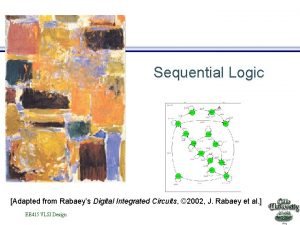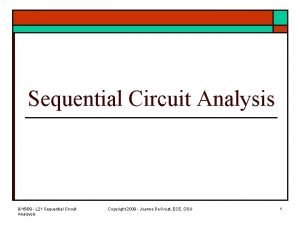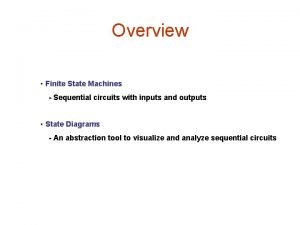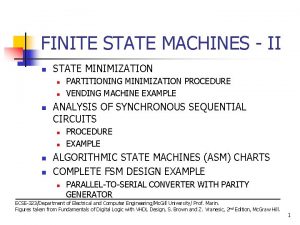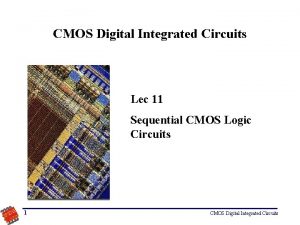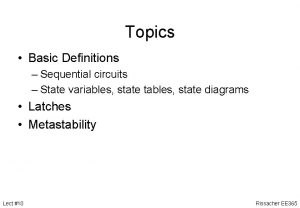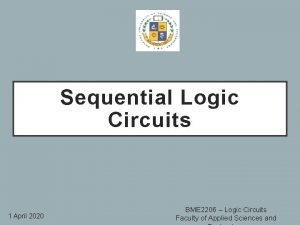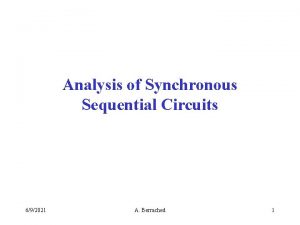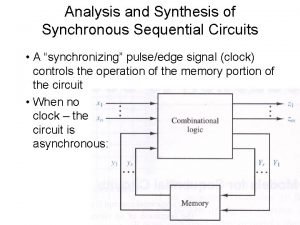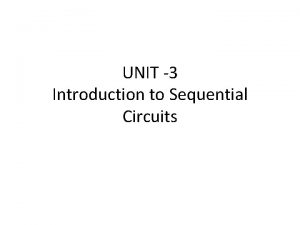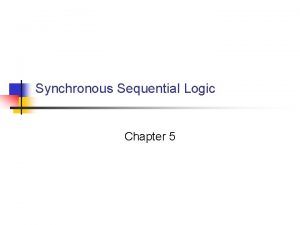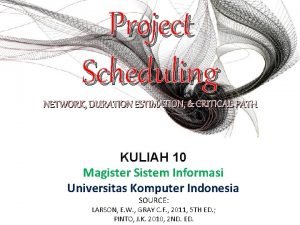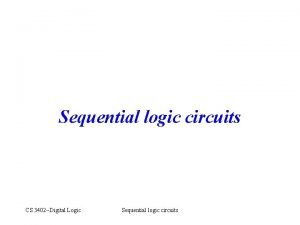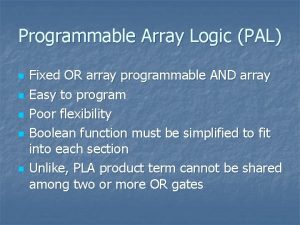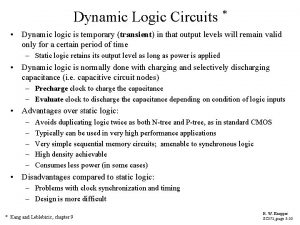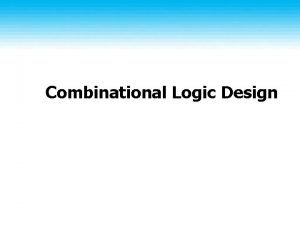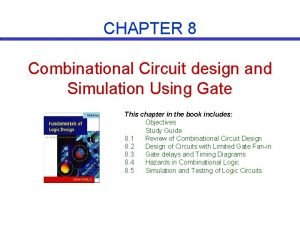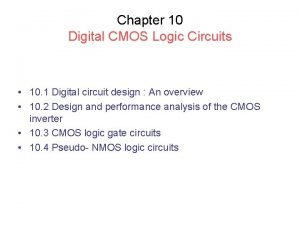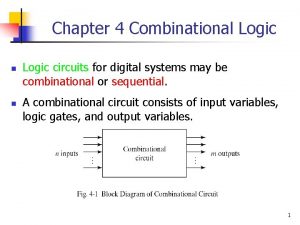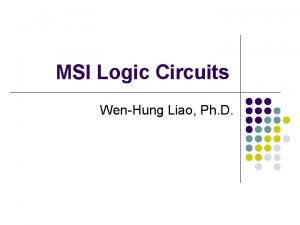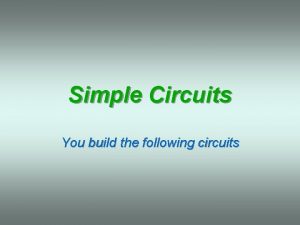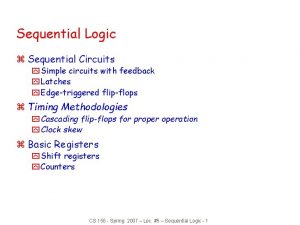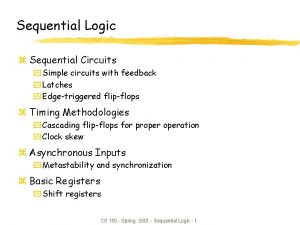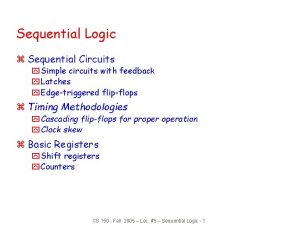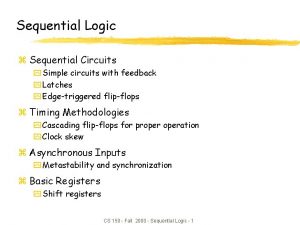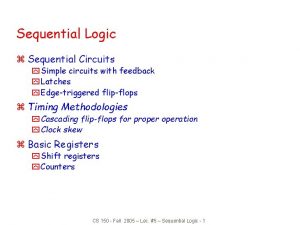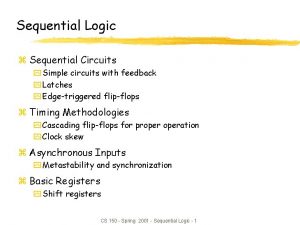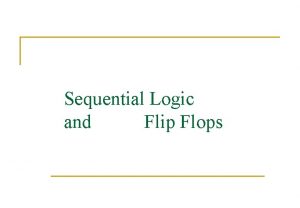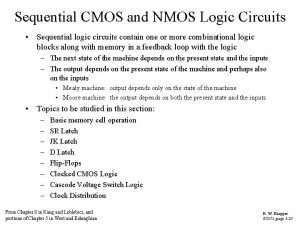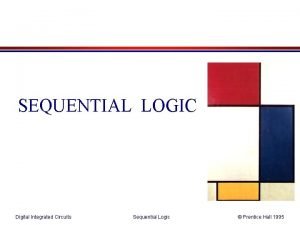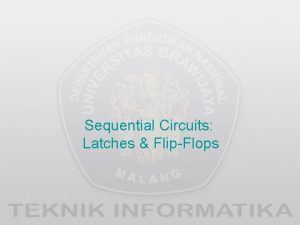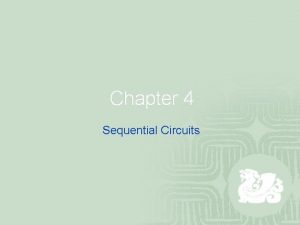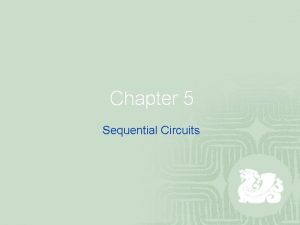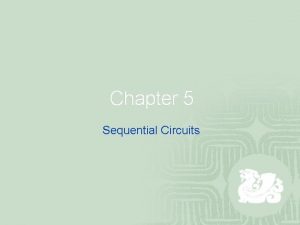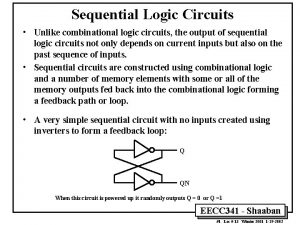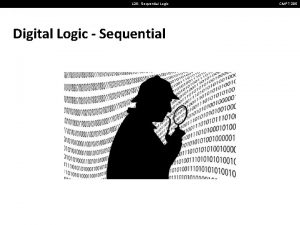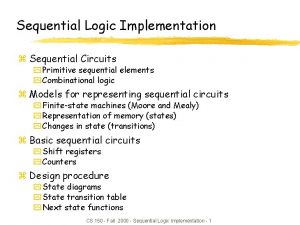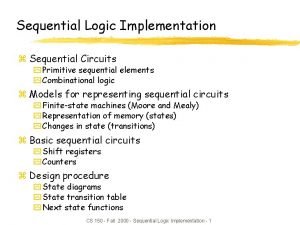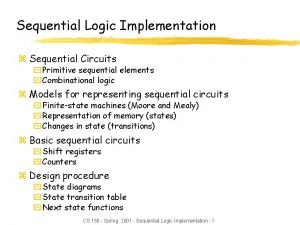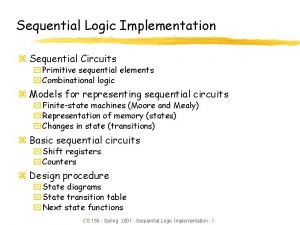Sequential Logic z Sequential Circuits y Simple circuits














































- Slides: 46

Sequential Logic z Sequential Circuits y Simple circuits with feedback y Latches y Edge-triggered flip-flops z Timing Methodologies y Cascading flip-flops for properation y Clock skew z Asynchronous Inputs y Metastability and synchronization z Basic Registers y Shift registers CS 150 - Fall 2000 - Sequential Logic - 1

Sequential Circuits z Circuits with Feedback y Outputs = f(inputs, past outputs) y Basis for building "memory" into logic circuits y Door combination lock is an example of a sequential circuit x. State is memory x. State is an "output" and an "input" to combinational logic x. Combination storage elements are also memory new equal reset value C 1 C 2 multiplexer C 3 mux control comb. logic state comparator equal open/closed CS 150 - Fall 2000 - Sequential Logic - 2 clock

Circuits with Feedback z How to control feedback? y What stops values from cycling around endlessly X 1 X 2 • • • Xn switching network Z 1 Z 2 • • • Zn CS 150 - Fall 2000 - Sequential Logic - 3

Simplest Circuits with Feedback z Two inverters form a static memory cell y Will hold value as long as it has power applied "1" "stored value" "0" z How to get a new value into the memory cell? y Selectively break feedback path y Load new value into cell "remember" "data" "load" CS 150 - Fall 2000 - Sequential Logic - 4 "stored value"

Memory with Cross-coupled Gates z Cross-coupled NOR gates y Similar to inverter pair, with capability to force output to 0 (reset=1) or 1 (set=1) R Q S Q' Q R S z Cross-coupled NAND gates y Similar to inverter pair, with capability to force output to 0 (reset=0) or 1 (set=0) S' R' Q S' R' CS 150 - Fall 2000 - Sequential Logic - 5 Q Q'

Timing Behavior Reset Hold R Q S Q' Set Reset Set R S Q Q CS 150 - Fall 2000 - Sequential Logic - 6 100 Race

State Behavior of R-S latch z Truth table of R-S latch behavior Q Q' 0 1 S 0 0 1 1 R 0 1 Q hold 0 1 unstable Q Q' 1 0 Q Q' 0 0 Q Q' 1 1 CS 150 - Fall 2000 - Sequential Logic - 7

Theoretical R-S Latch Behavior SR=10 SR=01 Q Q' 0 1 SR=01 Q Q' 1 0 SR=11 z State Diagram y States: possible values y Transitions: changes based on inputs SR=11 SR=01 possible oscillation between states 00 and 11 Q Q' 0 0 SR=11 SR=00 SR=10 Q Q' 1 1 CS 150 - Fall 2000 - Sequential Logic - 8 SR=00 SR=10

Observed R-S Latch Behavior z Very difficult to observe R-S latch in the 1 -1 state y One of R or S usually changes first z Ambiguously returns to state 0 -1 or 1 -0 y A so-called "race condition" y Or non-deterministic transition SR=10 SR=01 Q Q' 0 1 SR=01 Q Q' 1 0 SR=11 Q Q' 0 0 SR=11 SR=00 CS 150 - Fall 2000 - Sequential Logic - 9 SR=00 SR=10

R-S Latch Analysis z Break feedback path R Q Q(t) Q(t+ ) S Q' S S 0 0 1 1 R 0 0 1 1 Q(t) 0 1 0 1 Q(t+ ) 0 hold 1 0 reset 0 1 set 1 X not allowed X R S Q(t) 0 0 X 1 1 0 X 1 R characteristic equation Q(t+ ) = S + R’ Q(t) CS 150 - Fall 2000 - Sequential Logic - 10

Gated R-S Latch z Control when R and S inputs matter y Otherwise, the slightest glitch on R or S while enable is low could cause change in value stored Set R R' Q enable' Q' S' S 100 S' R' enable' Q Q' CS 150 - Fall 2000 - Sequential Logic - 11 Reset

Clocks z Used to keep time y Wait long enough for inputs (R' and S') to settle y Then allow to have effect on value stored z Clocks are regular periodic signals y Period (time between ticks) y Duty-cycle (time clock is high between ticks - expressed as % of period) duty cycle (in this case, 50%) period CS 150 - Fall 2000 - Sequential Logic - 12

Clocks (cont’d) z Controlling an R-S latch with a clock y Can't let R and S change while clock is active (allowing R and S to pass) y Only have half of clock period for signal changes to propagate y Signals must be stable for the other half of clock period R' R Q clock' S' Q' S stable changing stable R' and S' clock CS 150 - Fall 2000 - Sequential Logic - 13

Cascading Latches z Connect output of one latch to input of another z How to stop changes from racing through chain? y Need to control flow of data from one latch to the next y Advance from one latch per clock period y Worry about logic between latches (arrows) that is too fast R R Q' S S Q clock CS 150 - Fall 2000 - Sequential Logic - 14

Master-Slave Structure z Break flow by alternating clocks (like an air-lock) y Use positive clock to latch inputs into one R-S latch y Use negative clock to change outputs with another R-S latch z View pair as one basic unit y master-slave flip-flop y twice as much logic y output changes a few gate delays after the falling edge of clock but does not affect any cascaded flip-flops slave stage master stage R R Q' S S Q P' P CLK CS 150 - Fall 2000 - Sequential Logic - 15 R Q' S Q

The 1 s Catching Problem z In first R-S stage of master-slave FF y 0 -1 -0 glitch on R or S while clock is high "caught" by master stage y Leads to constraints on logic to be hazard-free slave stage master stage Set S R CLK P P' Q Q' Reset 1 s catch R R Q' S S Q CLK Master Outputs Slave Outputs CS 150 - Fall 2000 - Sequential Logic - 16 P' P R Q' S Q

D Flip-Flop z Make S and R complements of each other y Eliminates 1 s catching problem y Can't just hold previous value (must have new value ready every clock period) y Value of D just before clock goes low is what is stored in flipflop y Can make R-S flip-flop by adding logic to make D = S + R' Q slave stage master stage D R Q' S Q P' P CLK R Q' Q' S Q Q 10 gates CS 150 - Fall 2000 - Sequential Logic - 17

Edge-Triggered Flip-Flops z More efficient solution: only 6 gates y sensitive to inputs only near edge of clock signal (not while high) D’ D holds D' when clock goes low negative edge-triggered D flip-flop (D-FF) 0 R Q Clk=1 Q’ S 4 -5 gate delays must respect setup and hold time constraints to successfully capture input 0 holds D when clock goes low D D’ CS 150 - Fall 2000 - Sequential Logic - 18 characteristic equation Q(t+1) = D

Edge-Triggered Flip-Flops (cont’d) z Step-by-step analysis D’ D’ D D D’ R Q Clk=0 S S D D Q D’ when clock goes high-to-low data is latched D new D old D CS 150 - Fall 2000 - Sequential Logic - 19 D’ when clock is low data is held

Edge-Triggered Flip-Flops (cont’d) z Positive edge-triggered y Inputs sampled on rising edge; outputs change after rising edge z Negative edge-triggered flip-flops y Inputs sampled on falling edge; outputs change after falling edge 100 D CLK Qpos' Qneg' positive edge-triggered FF negative edge-triggered FF CS 150 - Fall 2000 - Sequential Logic - 20

Timing Methodologies z Rules for interconnecting components and clocks y Guarantee properation of system when strictly followed z Approach depends on building blocks used for memory elements y Focus on systems with edge-triggered flip-flops x. Found in programmable logic devices y Many custom integrated circuits focus on level-sensitive latches z Basic rules for correct timing: y (1) Correct inputs, with respect to time, are provided to the flipflops y (2) No flip-flop changes state more than once per clocking event CS 150 - Fall 2000 - Sequential Logic - 21

Timing Methodologies (cont’d) z Definition of terms y clock: periodic event, causes state of memory element to change; can be rising or falling edge, or high or low level y setup time: minimum time before the clocking event by which the input must be stable (Tsu) y hold time: minimum time after the clocking event until which the input must remain stable (Th) Tsu Th data D Q input clock there is a timing "window" around the clocking event during which the input must remain stable and unchanged in order to be recognized clock stable changing data clock CS 150 - Fall 2000 - Sequential Logic - 22 D Q

Comparison of Latches and Flip-Flops D Q CLK positive edge-triggered flip-flop D CLK Qedge D Q G Qlatch CLK transparent (level-sensitive) latch behavior is the same unless input changes while the clock is high CS 150 - Fall 2000 - Sequential Logic - 23

Comparison of Latches and Flip-Flops (cont’d) Type When inputs are sampled When output is valid unclocked latch always propagation delay from input change level-sensitive latch clock high (Tsu/Th around falling edge of clock) propagation delay from input change or clock edge (whichever is later) master-slave flip-flop clock high (Tsu/Th around falling edge of clock) propagation delay from falling edge of clock negative clock hi-to-lo transition propagation delay from falling edge-triggered (Tsu/Th around falling of clock flip-flop edge of clock) CS 150 - Fall 2000 - Sequential Logic - 24

Typical Timing Specifications z Positive edge-triggered D flip-flop y Setup and hold times y Minimum clock width y Propagation delays (low to high, high to low, max and typical) D CLK Q Tsu Th 20 ns 5 ns Tsu 20 ns Th 5 ns Tw 25 ns Tplh 25 ns 13 ns Tphl 40 ns 25 ns all measurements are made from the clocking event that is, the rising edge of the clock CS 150 - Fall 2000 - Sequential Logic - 25

Cascading Edge-triggered Flip-Flops z Shift register y New value goes into first stage y While previous value of first stage goes into second stage y Consider setup/hold/propagation delays (prop must be > hold) IN D Q Q 0 D Q Q 1 OUT CLK 100 IN Q 0 Q 1 CLK CS 150 - Fall 2000 - Sequential Logic - 26

Cascading Edge-triggered Flip-Flops (cont’d) z Why this works y Propagation delays exceed hold times y Clock width constraint exceeds setup time y This guarantees following stage will latch current value before it changes to new value In Tsu 4 ns Q 0 Tp 3 ns timing constraints guarantee properation of cascaded components Q 1 assumes infinitely fast distribution of the clock CLK Th 2 ns CS 150 - Fall 2000 - Sequential Logic - 27

Clock Skew z The problem y Correct behavior assumes next state of all storage elements determined by all storage elements at the same time y t. This is difficult in high-performance systems because time for clock to arrive at flip-flop is comparable to delays through logic y Effect of skew on cascaded flip-flops: 100 In Q 0 Q 1 CLK 0 CLK 1 is a delayed version of CLK 0 original state: IN = 0, Q 0 = 1, Q 1 = 1 due to skew, next state becomes: Q 0 = 0, Q 1 = 0, and not Q 0 = 0, Q 1 = 1 CS 150 - Fall 2000 - Sequential Logic - 28

Summary of Latches and Flip-Flops z Development of D-FF y Level-sensitive used in custom integrated circuits xcan be made with 4 switches y Edge-triggered used in programmable logic devices y Good choice for data storage register z Historically J-K FF was popular but now never used y Similar to R-S but with 1 -1 being used to toggle output (complement state) y Good in days of TTL/SSI (more complex input function: D = JQ' + K'Q y Not a good choice for PALs/PLAs as it requires 2 inputs y Can always be implemented using D-FF z Preset and clear inputs are highly desirable on flip-flops y Used at start-up or to reset system to a known state CS 150 - Fall 2000 - Sequential Logic - 29

Metastability and Asynchronous inputs z Clocked synchronous circuits y Inputs, state, and outputs sampled or changed in relation to a common reference signal (called the clock) y E. g. , master/slave, edge-triggered z Asynchronous circuits y Inputs, state, and outputs sampled or changed independently of a common reference signal (glitches/hazards a major concern) y E. g. , R-S latch z Asynchronous inputs to synchronous circuits y Inputs can change at any time, will not meet setup/hold times y Dangerous, synchronous inputs are greatly preferred y Cannot be avoided (e. g. , reset signal, memory wait, user input) CS 150 - Fall 2000 - Sequential Logic - 30

Synchronization Failure z Occurs when FF input changes close to clock edge y FF may enter a metastable state – neither a logic 0 nor 1 – y May stay in this state an indefinite amount of time y Is not likely in practice but has some probability logic 1 logic 0 logic 1 small, but non-zero probability that the FF output will get stuck in an in-between state logic 0 oscilloscope traces demonstrating synchronizer failure and eventual decay to steady state CS 150 - Fall 2000 - Sequential Logic - 31

Dealing with Synchronization Failure z Probability of failure can never be reduced to 0, but it can be reduced y (1) slow down the system clock: this gives the synchronizer more time to decay into a steady state; synchronizer failure becomes a big problem for very high speed systems y (2) use fastest possible logic technology in the synchronizer: this makes for a very sharp "peak" upon which to balance y (3) cascade two synchronizers: this effectively synchronizes twice (both would have to fail) asynchronous input D Q D synchronized input Q Clk CS 150 - Fall 2000 - Sequential Logic - 32 synchronous system

Handling Asynchronous Inputs z Never allow asynchronous inputs to fan-out to more than one flip-flop y Synchronize as soon as possible and then treat as synchronous signal Clocked Synchronous System Async Input D Q Synchronizer Q 0 Async Input D Q Clock D Q Q 1 Clock CS 150 - Fall 2000 - Sequential Logic - 33 Q 0 D Q Q 1 Clock

Handling Asynchronous Inputs (cont’d) z What can go wrong? y Input changes too close to clock edge (violating setup time constraint) In In is asynchronous and fans out to D 0 and D 1 Q 0 one FF catches the signal, one does not Q 1 inconsistent state may be reached! CLK CS 150 - Fall 2000 - Sequential Logic - 34

Flip-Flop Features z Reset (set state to 0) – R y Synchronous: Dnew = R' • Dold (when next clock edge arrives) y Asynchronous: doesn't wait for clock, quick but dangerous z Preset or set (set state to 1) – S (or sometimes P) y Synchronous: Dnew = Dold + S (when next clock edge arrives) y Asynchronous: doesn't wait for clock, quick but dangerous z Both reset and preset y Dnew = R' • Dold + S y Dnew = R' • Dold + R'S (set-dominant) (reset-dominant) z Selective input capability (input enable/load) – LD or EN y Multiplexer at input: Dnew = LD' • Q + LD • Dold y Load may/may not override reset/set (usually R/S have priority) z Complementary outputs – Q and Q' CS 150 - Fall 2000 - Sequential Logic - 35

Registers z Collections of flip-flops with similar controls and logic y Stored values somehow related (e. g. , form binary value) y Share clock, reset, and set lines y Similar logic at each stage z Examples y Shift registers y Counters OUT 1 OUT 2 OUT 3 OUT 4 "0" R S R S D Q D Q CLK IN 1 IN 2 IN 3 CS 150 - Fall 2000 - Sequential Logic - 36 IN 4

Shift Register z Holds samples of input y Store last 4 input values in sequence y 4 -bit shift register: OUT 1 IN D Q OUT 2 D Q CLK CS 150 - Fall 2000 - Sequential Logic - 37 OUT 3 D Q OUT 4

Universal Shift Register z Holds 4 values y Serial or parallel inputs y Serial or parallel outputs y Permits shift left or right y Shift in new values from left or right output left_in left_out clear s 0 s 1 right_out right_in clock input clear sets the register contents and output to 0 s 1 and s 0 determine the shift function s 0 0 0 1 1 CS 150 - Fall 2000 - Sequential Logic - 38 s 1 0 1 function hold state shift right shift left load new input

Design of Universal Shift Register z Consider one of the four flip-flops y New value at next clock cycle: Nth cell to N-1 th cell clear 1 0 0 s 0 – 0 0 1 1 s 1 – 0 1 new value 0 output value of FF to left (shift right) output value of FF to right (shift left) input to N+1 th cell Q D CLK CLEAR 0 1 2 3 s 0 and s 1 control mux Q[N-1] (left) CS 150 - Fall 2000 - Sequential Logic - 39 Input[N] Q[N+1] (right)

Shift Register Application z Parallel-to-serial conversion for serial transmission parallel outputs parallel inputs serial transmission CS 150 - Fall 2000 - Sequential Logic - 40

Pattern Recognizer z Combinational function of input samples y In this case, recognizing the pattern 1001 on the single input signal OUT 1 IN D Q OUT 2 D Q OUT 3 D Q CLK CS 150 - Fall 2000 - Sequential Logic - 41 OUT 4

Counters z Sequences through a fixed set of patterns y In this case, 1000, 0100, 0010, 0001 y If one of the patterns is its initial state (by loading or set/reset) OUT 1 IN D Q OUT 2 D Q OUT 3 OUT 4 D Q CLK z Mobius (or Johnson) counter y In this case, 1000, 1110, 1111, 0011, 0000 OUT 1 IN D Q OUT 2 D Q CLK CS 150 - Fall 2000 - Sequential Logic - 42 OUT 3 D Q OUT 4

Binary Counter z Logic between registers (not just multiplexer) y XOR decides when bit should be toggled y Always for low-order bit, only when first bit is true for second bit, and so on OUT 1 D Q OUT 2 D Q OUT 3 D Q CLK "1" CS 150 - Fall 2000 - Sequential Logic - 43 OUT 4 D Q

Four-bit Binary Synchronous Up-Counter z Standard component with many applications y Positive edge-triggered FFs w/ sync load and clear inputs y Parallel load data from D, C, B, A y Enable inputs: must be asserted to enable counting y RCO: ripple-carry out used for cascading counters xhigh when counter is in its highest state 1111 ximplemented using an AND gate EN (2) RCO goes high (3) High order 4 -bits are incremented (1) Low order 4 -bits = 1111 CS 150 - Fall 2000 - Sequential Logic - 44 D C RCO B QD A QC LOAD QB QA CLK CLR

Offset Counters z Starting offset counters – use of synchronous load y e. g. , 0110, 0111, 1000, 1001, 1010, 1011, 1100, 1101, 1111, 0110, . . . z Ending offset counter – comparator for ending value "1" "0" EN RCO QD QC QB QA D C B A LOAD CLK CLR y e. g. , 0000, 0001, 0010, . . . , 1100, 1101, 0000 z Combinations of the above (start and stop value) CS 150 - Fall 2000 - Sequential Logic - 45 "1" "0" "0" EN D C B A LOAD CLK CLR RCO QD QC QB QA

Sequential Logic Summary z Fundamental building block of circuits with state y Latch and flip-flop y R-S latch, R-S master/slave, D master/slave, edge-triggered D FF z Timing methodologies y Use of clocks y Cascaded FFs work because prop delays exceed hold times y Beware of clock skew z Asynchronous inputs and their dangers y Synchronizer failure: what it is and how to minimize its impact z Basic registers y Shift registers y Pattern detectors y Counters CS 150 - Fall 2000 - Sequential Logic - 46
 Combinational vs sequential logic
Combinational vs sequential logic Software development plan
Software development plan Combinational logic sequential logic
Combinational logic sequential logic Combinational logic sequential logic 차이
Combinational logic sequential logic 차이 Logic chapter 3
Logic chapter 3 Non bistable sequential circuits
Non bistable sequential circuits Analysis of sequential circuits
Analysis of sequential circuits Synchronous sequential circuits examples
Synchronous sequential circuits examples Finite state machine sequential circuits
Finite state machine sequential circuits Analysis of sequential circuits
Analysis of sequential circuits Analysis of sequential circuits
Analysis of sequential circuits Non bistable sequential circuits
Non bistable sequential circuits Sequential circuits prelude
Sequential circuits prelude Sequential circuits
Sequential circuits State diagram
State diagram Analysis of synchronous sequential circuits
Analysis of synchronous sequential circuits State diagram
State diagram 74ls112
74ls112 Moore machine and mealy machine
Moore machine and mealy machine Digital circuits
Digital circuits Advantages of parallel circuit over series circuit
Advantages of parallel circuit over series circuit Predecessor table
Predecessor table What is a nonserual sequential logic in project
What is a nonserual sequential logic in project Programmable devices
Programmable devices Sequential
Sequential Programmable array logic circuit
Programmable array logic circuit Cascading dynamic gates
Cascading dynamic gates Combinational logic circuits
Combinational logic circuits Combinational circuit design
Combinational circuit design Nmos logic circuits
Nmos logic circuits Combinational logic circuits lab report
Combinational logic circuits lab report And gate minecraft
And gate minecraft 2057 octal to decimal
2057 octal to decimal Binary systems and logic circuits
Binary systems and logic circuits Binary full subtractor
Binary full subtractor Chapter 4 combinational logic circuits
Chapter 4 combinational logic circuits Msi logic circuits
Msi logic circuits First order logic vs propositional logic
First order logic vs propositional logic First order logic vs propositional logic
First order logic vs propositional logic First order logic vs propositional logic
First order logic vs propositional logic Cryptarithmetic problem logic+logic=prolog
Cryptarithmetic problem logic+logic=prolog Simple circuits worksheet
Simple circuits worksheet Present simple and future simple
Present simple and future simple Simple present and simple future
Simple present and simple future Simple past simple present simple future
Simple past simple present simple future Without information
Without information Simple present, simple past, simple future
Simple present, simple past, simple future





